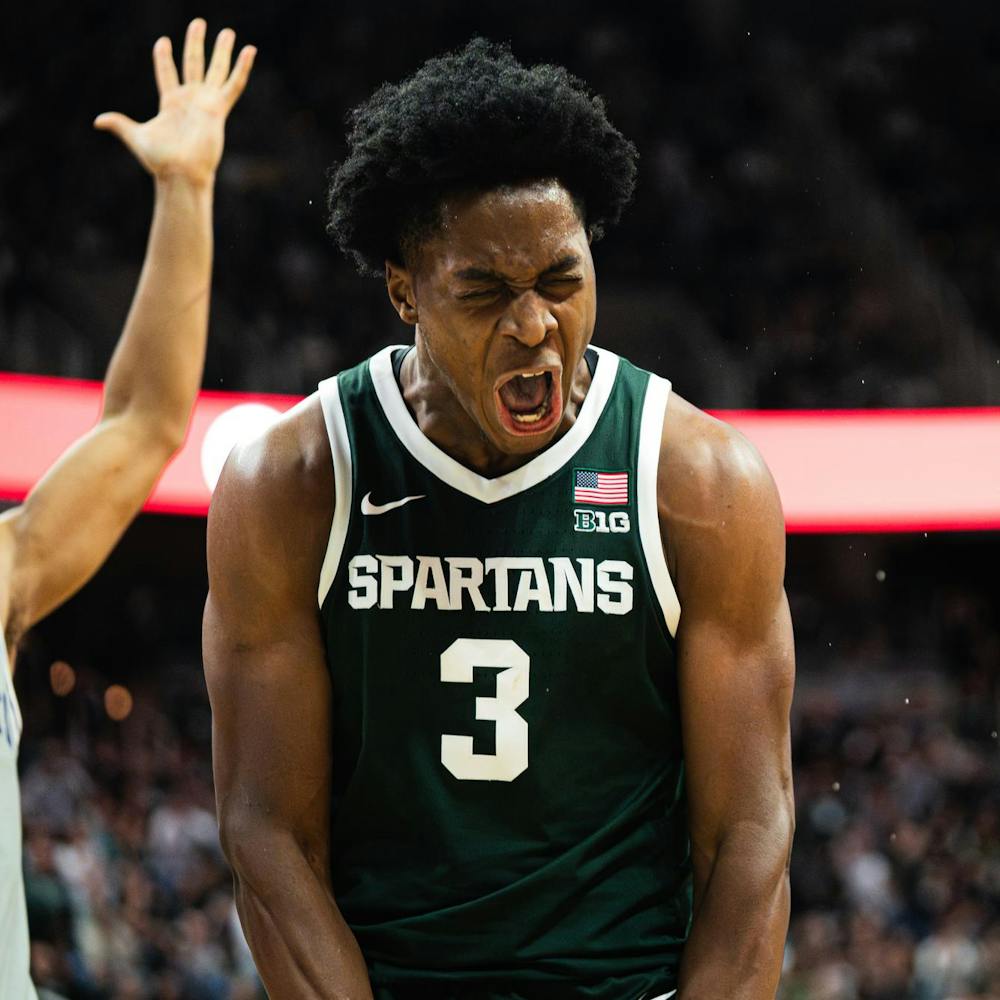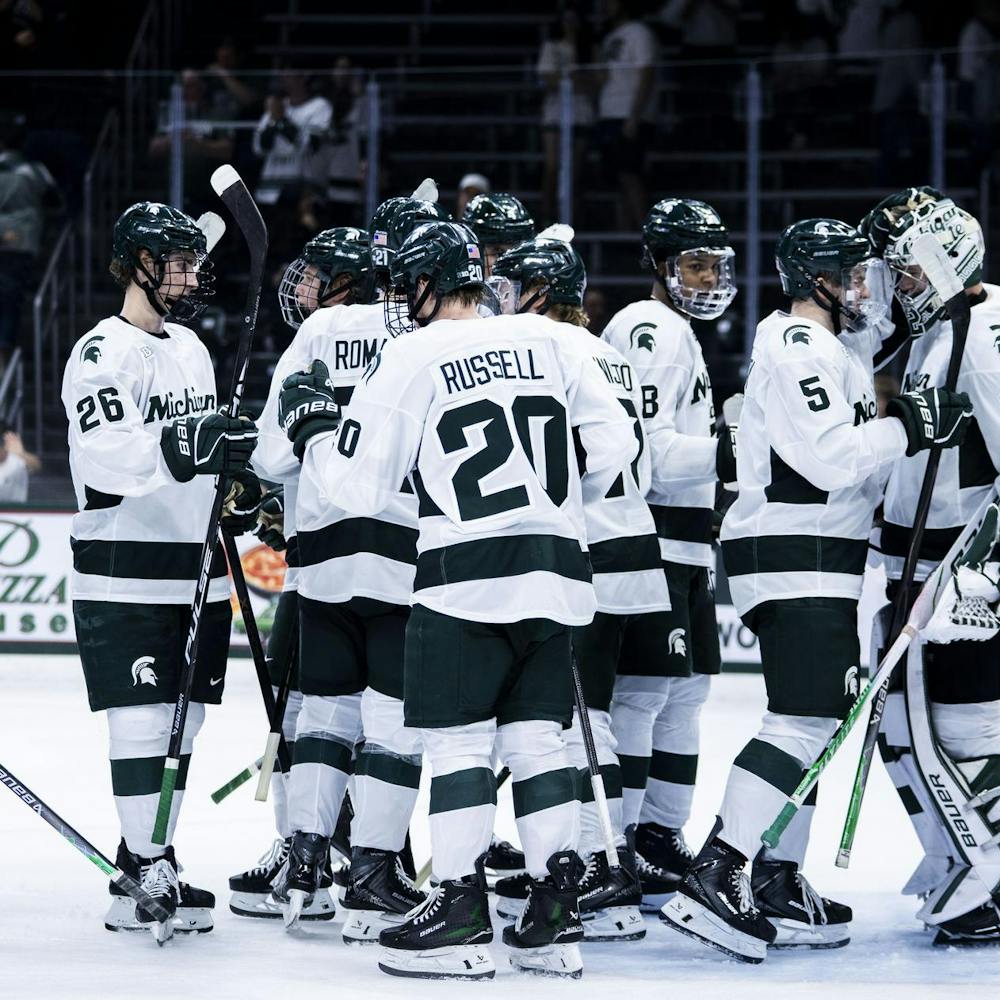One day after running in his first marathon, Jay Hanna already is planning the next one.
Forget that he's sore — the inevitable result of the 26.2-mile run through Detroit and Windsor, Ontario, on Sunday — or that he's walking with a slight limp.
He doesn't care.
Running is how he clears his mind. How he relieves stress. How he sifts through all the thoughts flowing through his brain.
The last several months have given him plenty to think about.
Hanna, 22, is recovering from a drinking problem. Even though his situation isn't the most common experience with alcohol MSU health educators see from students, it can happen. Most of the issues Olin Health Center handles concern "episodic, high-risk drinking," or instances of heavy drinking sometimes associated with celebratory events.
Hanna, a supply chain management senior, said he's glad he caught it before it became an even bigger problem.
He will have been sober six months on Nov. 11, but unlike other anniversaries, this is not one he plans to share.
"It's Jay's day," Hanna said. "It's a surprise not only to myself, but to others. More important, I just keep it logged in the back of my head of how far I've come.
"I don't want to go back to the place I was at."
'Everyone did it'
Growing up in Bexley, Ohio, just outside Columbus, Hanna began drinking at age 15. He said getting alcohol was easy. In high school, Hanna and his friends — a "crazy group of kids," he said — partied three or four times a week.
"We were always looking for the party, making the party happen," he said. "As soon as someone's parents weren't home — even if their parents were home — we'd go in the basement.
"It was just very prevalent. Everyone did it."
Hanna's parents knew he partied, but he said they didn't know the extent of his drinking.
At MSU, Hanna would drink at least five nights a week. But going to parties or to the bar weren't the only times he would indulge.
"It was never just three or four (drinks)," he said. "It was always 'get wasted.' And the worst thing was blacking out toward the end. I'd black out all the time.
"I was 'that guy' — I was always there, always drunk."
Part of the problem, Hanna said, was the availability of alcohol and the fact that the type of students who drank came from a number of different groups, rather than just "the bad high school kids." To Hanna, everyone in college drank alcohol — or so it seemed.
"It's socially accepted, and that's the hard thing about college — it's everywhere," he said.
Maybe not.
Rebecca Allen, a health educator who deals with alcohol, tobacco and drug prevention at Olin Health Center, said the center's research shows most MSU students drink moderately most of the time. Between 22 and 24 percent don't drink or drink very infrequently.
Part of that, Allen said, can be attributed to Olin's social norms campaign. For four years now, health educators have presented their data about student drinking in order to curb misconceptions that "everyone does it."
If the students who drink moderately see that their behavior is common among other students, they're more likely to continue that pattern, Allen said.
"If students think that most of their peers drink eight to 10 (drinks), it makes it more likely that they will drink eight to 10 or at a level they're not comfortable with," she said. "If you correct the misperceptions about health behavior, the behavior will fall more in line with the norm."
Recognizing a problem
While studying abroad in Australia earlier this year, Hanna decided to stop drinking altogether. He said there was never one defining moment, but a bunch of little things finally added up.
"Things started to happen, people started to make comments about how much I drink," Hanna said. "Embarrassing things started happening that usually happened once or twice a month — (they) were now happening once or twice a week.
"I didn't want to wake up when I was 40 and say, 'What happened to my life?'"
On the trip, which lasted from January until July, he reached a "turning point."
Hanna was thrown out of a bar in Australia for refilling his own beer. Later that night, he called his family while drunk and said he thought he had a drinking problem. He doesn't remember the conversation.
"I woke up and I had, like, 50 missed calls from them," Hanna said. "I thought someone had died.
"It's depressing when you get to that point and you don't even remember," he said. "I felt like I had let them down, but they were so supportive."
One in every 10 adult drinkers will develop an addiction to alcohol, Allen said, but a person can have a drinking problem without ever being addicted.
Signs of a problem in students include frequent blackouts and sickness, a decline in academic focus or performance and going to a bar or party they didn't intend to go to by themselves or with a different group.
"If that happens pretty consistently, or at least more frequently than you'd want it to, it's a pretty good indicator that alcohol has more control over you than you have over it," Allen said. "People can have a problem with alcohol and not necessarily have an alcohol problem."
As a health educator, Allen sees or hears from about 20 students each semester who are worried about their own drinking. The beginning of the year and the end of a semester are common times for visits.
If a student comes to talk to her, Allen will discuss the student's drinking behavior and can give referrals to other departments or agencies, depending on the situation.
The MSU Counseling Center, she said, can diagnose an alcohol problem, as well as provide an assessment and substance-abuse counseling.
A new online resource, e-CHUG, will allow students to assess their own drinking, particularly in terms of whether or not they could have problems with alcohol. Run through Olin, the site uses a tool that can provide reliable results, Allen said.
The episodic, heavy drinking Olin health educators see most is prevalent among college students.
Not only is the amount of alcohol consumed a factor, but the rate at which it is consumed also plays a role in determining risk, Allen said.
"It's really about whether you have control," she said. "Bottom line — can you control when you end?"
Road to recovery
One of the biggest things Hanna encountered after he stopped drinking is the lifestyle change.
He has drifted apart from friends who used to party with him. Some people, he said, aren't sure how to approach him when they're drinking. His new vice is caffeine.
But Hanna feels healthier. He attends Alcoholics Anonymous meetings as often as once or twice a week. And he doesn't take the important things in life for granted.
"It's just tough to be in college when drinking is so prevalent, but it was just time for me to go a different path," Hanna said. "I've known people who have alcoholism. I've seen what it does to their lives. I thought it'd be better to address the problem now before it became full-blown."
The MSU Counseling Center offers assessments to students who are concerned about their drinking. Substance-abuse counselors work with the students to learn more about their substance-use history and other aspects of their lives that could contribute to a drinking problem, said Robert W. Eubanks, a substance-abuse counselor with the center.
From there, counselors determine whether a student is chemically dependent or addicted, or in some less-severe stage of substance abuse, Eubanks said, and can recommend treatment or information to help students stop drinking.
"One of the things we ask for students to do is to learn what their high-risk drinking situations are, to become more aware of the events in their life that trigger an urge or a desire to drink or to use substances," he said. "(Our job is) to help students discover new alcohol-free or substance-use-free ways of coping with their life problems."
Eubanks said students are successful at controlling their drinking when they seek advice from the Counseling Center, but counselors remain concerned about those students who never seek help.
The number of students the center sees, he said, is not representative of the total number of students who actually are having a problem with alcohol.
"What we'd like to accomplish better is to just reach more students," Eubanks said. "When students come in here, they get better. The issue is what happens when students don't come in and need to."
Support has made it easier for Hanna in making his decision to quit drinking, especially from his family and friends. His roommates are respectful of Hanna's choice when throwing a party, and two of them are running partners.
Hanna ran the Detroit Free Press/Flagstar Bank Marathon on Sunday with his friend and roommate, Nick Peraino. The men clocked in at 3 hours and 51 minutes — but now they're going to follow a stricter training regimen to shave crucial seconds off their time.
"We were talking about doing one in April in Toledo, just try to improve our time and eventually qualify for Boston, which is 3 hours and 10 minutes for our age group," Hanna said.
Peraino, a construction management junior, didn't run much until Hanna took up the activity. He said having someone to run with him makes the weekly 15-mile course they run across town much easier to accomplish.
"Jay was kind of like my inspiration," Peraino said. "It's a lot more difficult to go out and train by yourself. It makes it more interesting and not as boring."
During the race, Hanna said he could feel the energy of both spectators and competitors. Onlookers cheered on the runners as they passed, and runners would pump up the spirits of other racers.
The support, Hanna said, kept him encouraged — the way it keeps him committed to an alcohol-free life.
"It's changed my whole outlook on life," Hanna said. "My personality has changed, my lifestyle has changed. To be honest, I think I've become a better person."






